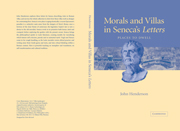Book contents
- Frontmatter
- Contents
- Acknowledgements
- Introduction
- 1 Twelve steps to haven
- 2 Dropping in (it) at SENECA'S
- 3 You can get used to anything
- 4 The long and winding mode
- 5 Booking us in
- 6 Now and then; here and there: at SCIPIO'S
- 7 Bound for VATIA'S
- 8 Knocking the self: genuflexion, villafication, VATIA'S
- 9 The world of the bath-house: SCIPIO'S
- 10 The appliance of science: SCIPIO'S
- 11 Shafts of light: transplantation and transfiguration
- 12 Still olive, still SCIPIO'S
- Appendix 1 Here to stay Places and persons named in the Epistulae Morales
- Appendix 2 From: Letter 86 To: A Dying Light in Corduba
- Bibliography
- Indexes
6 - Now and then; here and there: at SCIPIO'S
Text and translation of Letter 86
Published online by Cambridge University Press: 22 September 2009
- Frontmatter
- Contents
- Acknowledgements
- Introduction
- 1 Twelve steps to haven
- 2 Dropping in (it) at SENECA'S
- 3 You can get used to anything
- 4 The long and winding mode
- 5 Booking us in
- 6 Now and then; here and there: at SCIPIO'S
- 7 Bound for VATIA'S
- 8 Knocking the self: genuflexion, villafication, VATIA'S
- 9 The world of the bath-house: SCIPIO'S
- 10 The appliance of science: SCIPIO'S
- 11 Shafts of light: transplantation and transfiguration
- 12 Still olive, still SCIPIO'S
- Appendix 1 Here to stay Places and persons named in the Epistulae Morales
- Appendix 2 From: Letter 86 To: A Dying Light in Corduba
- Bibliography
- Indexes
Summary
The journey to the villa of Scipio Africanus, conqueror of Hannibal's Carthage, is over before it is begun.
Seneca is already (cushioned?) on the ground there as Epp. 86 begins (iacens). He has not left this manor; he will give us no hint that he has been this way before; he is still there, right now, at the eternal moment of epistolary address.
But Letter 12 pre-primed us to ‘moralize’ the first-person narrative of the owner's visit to his mansion, and interference in its gardening, for scrutiny of his imaged self. Everything we have learned about the Letters has told us to respond by working through intimate exchange with the writer and his presumptions about the reader. We always undergo manipulation; we always have the manipulator's self-manipulation before us, as mirror of the terms for our own engagement.
Where are we as we start on scipio's?
Our approach, and gateway: we were handed a negative proof of the ideal mansion in the caricature of vatia's (Epp. 55).
We were invited both to read the Letters as the transmogrified product of the reading of classic ‘liberal’ texts, and specifically to subsume gleanings from the philosophy of Virgil's Georgics into our reception of Seneca's deployment of rustic imagery in pursuit of Virtue (Epp. 84, cf. 87, 88).
If reception of a ‘mansion’ could bridge to hubbub from a ‘bath-house’ once, then it can happen again. And why not within, rather than between, site or sites, Letter or Letters (∼ 55–6)?
- Type
- Chapter
- Information
- Morals and Villas in Seneca's LettersPlaces to Dwell, pp. 53 - 61Publisher: Cambridge University PressPrint publication year: 2004



